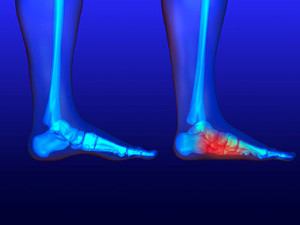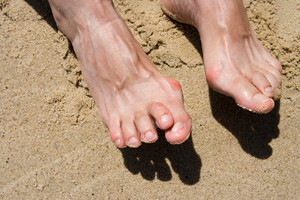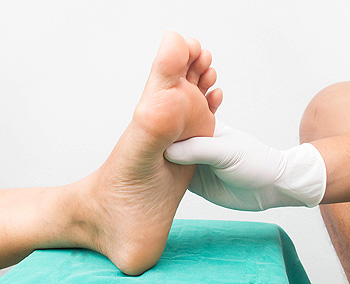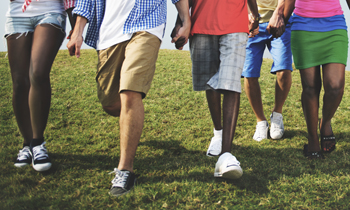Blog
Items filtered by date: July 2020
How to Determine If I Have Flat Feet
 The condition that is known as flat feet can be noticeable while standing on the floor. The arch area of the feet will lie flat on the floor, and the feet may feel achy. The majority of babies are born with flat feet, and the arch typically develops throughout childhood. The arch provides flexibility between the front and back of the foot, in addition to dispersing body weight while standing up. Many patients with flat feet choose to wear custom made orthotics, and this may help to provide mild relief with additional cushioning. If you have pain in your feet and think you may have flat feet, it is suggested that you consult with a podiatrist who can properly diagnose you and offer treatment options.
The condition that is known as flat feet can be noticeable while standing on the floor. The arch area of the feet will lie flat on the floor, and the feet may feel achy. The majority of babies are born with flat feet, and the arch typically develops throughout childhood. The arch provides flexibility between the front and back of the foot, in addition to dispersing body weight while standing up. Many patients with flat feet choose to wear custom made orthotics, and this may help to provide mild relief with additional cushioning. If you have pain in your feet and think you may have flat feet, it is suggested that you consult with a podiatrist who can properly diagnose you and offer treatment options.
Flatfoot is a condition many people suffer from. If you have flat feet, contact one of our podiatrists from Romeo Foot & Ankle Clinic. Our doctors will treat your foot and ankle needs.
What Are Flat Feet?
Flatfoot is a condition in which the arch of the foot is depressed and the sole of the foot is almost completely in contact with the ground. About 20-30% of the population generally has flat feet because their arches never formed during growth.
Conditions & Problems:
Having flat feet makes it difficult to run or walk because of the stress placed on the ankles.
Alignment – The general alignment of your legs can be disrupted, because the ankles move inward which can cause major discomfort.
Knees – If you have complications with your knees, flat feet can be a contributor to arthritis in that area.
Symptoms
- Pain around the heel or arch area
- Trouble standing on the tip toe
- Swelling around the inside of the ankle
- Flat look to one or both feet
- Having your shoes feel uneven when worn
Treatment
If you are experiencing pain and stress on the foot you may weaken the posterior tibial tendon, which runs around the inside of the ankle.
If you have any questions please feel free to contact our offices located in Washington and Shelby Townships, MI . We offer the newest diagnostic and treatment technologies for all your foot and ankle needs.
Common Reasons a Hammertoe May Develop
 Hammertoes, as its name suggests, may cause the affected toe to bend downward, resembling a hammer-like shape. Typically, this condition can affect the second, third, or fourth toes. Because hammertoes can be painful and cause a great deal of discomfort, it’s important that you seek professional help if you notice your toe’s appearance has become deformed. Common causes for a hammertoe’s development include a muscle imbalance, tightly-fitted footwear, a previous injury, and certain diseases such as arthritis or diabetes. Along with the noticeable change of appearance of the affected toe, some may also experience swelling, redness, a burning sensation, and the development of corns or calluses on the top of the middle joint of the affected toe. For more advice on how to treat a hammertoe, please seek the professional guidance of a podiatrist.
Hammertoes, as its name suggests, may cause the affected toe to bend downward, resembling a hammer-like shape. Typically, this condition can affect the second, third, or fourth toes. Because hammertoes can be painful and cause a great deal of discomfort, it’s important that you seek professional help if you notice your toe’s appearance has become deformed. Common causes for a hammertoe’s development include a muscle imbalance, tightly-fitted footwear, a previous injury, and certain diseases such as arthritis or diabetes. Along with the noticeable change of appearance of the affected toe, some may also experience swelling, redness, a burning sensation, and the development of corns or calluses on the top of the middle joint of the affected toe. For more advice on how to treat a hammertoe, please seek the professional guidance of a podiatrist.
Hammertoe
Hammertoes can be a painful condition to live with. For more information, contact one of our podiatrists from Romeo Foot & Ankle Clinic. Our doctors will answer any of your foot- and ankle-related questions.
Hammertoe is a foot deformity that affects the joints of the second, third, fourth, or fifth toes of your feet. It is a painful foot condition in which these toes curl and arch up, which can often lead to pain when wearing footwear.
Symptoms
- Pain in the affected toes
- Development of corns or calluses due to friction
- Inflammation
- Redness
- Contracture of the toes
Causes
Genetics – People who are genetically predisposed to hammertoe are often more susceptible
Arthritis – Because arthritis affects the joints in your toes, further deformities stemming from arthritis can occur
Trauma – Direct trauma to the toes could potentially lead to hammertoe
Ill-fitting shoes – Undue pressure on the front of the toes from ill-fitting shoes can potentially lead to the development of hammertoe
Treatment
Orthotics – Custom made inserts can be used to help relieve pressure placed on the toes and therefore relieve some of the pain associated with it
Medications – Oral medications such as anti-inflammatories or NSAIDs could be used to treat the pain and inflammation hammertoes causes. Injections of corticosteroids are also sometimes used
Surgery – In more severe cases where the hammertoes have become more rigid, foot surgery is a potential option
If you have any questions please contact our offices located in Washington and Shelby Townships, MI . We offer the newest diagnostic and treatment technologies for all your foot and ankle needs.
What Are Common Signs of Neuropathy?
 Neuropathy may be brought upon by nerve damage and can cause serious issues for the feet if left unmonitored. This condition can be fairly common among diabetic patients, often causing a loss of feeling or numbing sensation of the feet. There are a few indicators, along with the numbing and tingling of the feet, one may look out for. Some patients may experience a throbbing, burning, or stabbing type of foot pain. Because neuropathy is caused by nerve damage, these issues can lead to changes in the size and shape of the foot. It can also be common for patients with neuropathy to develop foot ulcers. Ulcers, which are deep, open wounds, can form due to neglecting cuts or scrapes on the feet, and can often lead to infection. For professional care and an advised treatment plan, please consult with a podiatrist.
Neuropathy may be brought upon by nerve damage and can cause serious issues for the feet if left unmonitored. This condition can be fairly common among diabetic patients, often causing a loss of feeling or numbing sensation of the feet. There are a few indicators, along with the numbing and tingling of the feet, one may look out for. Some patients may experience a throbbing, burning, or stabbing type of foot pain. Because neuropathy is caused by nerve damage, these issues can lead to changes in the size and shape of the foot. It can also be common for patients with neuropathy to develop foot ulcers. Ulcers, which are deep, open wounds, can form due to neglecting cuts or scrapes on the feet, and can often lead to infection. For professional care and an advised treatment plan, please consult with a podiatrist.
Neuropathy
Neuropathy can be a potentially serious condition, especially if it is left undiagnosed. If you have any concerns that you may be experiencing nerve loss in your feet, consult with one of our podiatrists from Romeo Foot & Ankle Clinic. Our doctors will assess your condition and provide you with quality foot and ankle treatment for neuropathy.
What Is Neuropathy?
Neuropathy is a condition that leads to damage to the nerves in the body. Peripheral neuropathy, or neuropathy that affects your peripheral nervous system, usually occurs in the feet. Neuropathy can be triggered by a number of different causes. Such causes include diabetes, infections, cancers, disorders, and toxic substances.
Symptoms of Neuropathy Include:
- Numbness
- Sensation loss
- Prickling and tingling sensations
- Throbbing, freezing, burning pains
- Muscle weakness
Those with diabetes are at serious risk due to being unable to feel an ulcer on their feet. Diabetics usually also suffer from poor blood circulation. This can lead to the wound not healing, infections occurring, and the limb may have to be amputated.
Treatment
To treat neuropathy in the foot, podiatrists will first diagnose the cause of the neuropathy. Figuring out the underlying cause of the neuropathy will allow the podiatrist to prescribe the best treatment, whether it be caused by diabetes, toxic substance exposure, infection, etc. If the nerve has not died, then it’s possible that sensation may be able to return to the foot.
Pain medication may be issued for pain. Electrical nerve stimulation can be used to stimulate nerves. If the neuropathy is caused from pressure on the nerves, then surgery may be necessary.
If you have any questions, please feel free to contact our offices located in Washington and Shelby Townships, MI . We offer the newest diagnostic and treatment technologies for all your foot care needs.
Tips for Healthy Feet
 One of the most important parts of keeping your feet healthy and pain-free involves preventative steps. To start, cleaning your feet and keeping them dry is key to avoid fungal infections that may grow in moisture. Fungal infections are common in public places such as pools, locker rooms, and showers. It is crucial to protect your feet with shower shoes when visiting these areas. Examining your feet is paramount in tackling issues early on. Peeling between the toes could signal athlete’s foot, and discolored nails may be an indication of a nail fungus. Choosing the correct footwear can also be beneficial for the feet. Purchase shoes at the end of the day when the feet are at their largest and avoid shoes that cramp the toes as this could lead to ingrown toenails, bunions, and calluses. If you are experiencing any type of foot pain or would like additional information on keeping the feet healthy, please speak with a podiatrist for professional care and treatment.
One of the most important parts of keeping your feet healthy and pain-free involves preventative steps. To start, cleaning your feet and keeping them dry is key to avoid fungal infections that may grow in moisture. Fungal infections are common in public places such as pools, locker rooms, and showers. It is crucial to protect your feet with shower shoes when visiting these areas. Examining your feet is paramount in tackling issues early on. Peeling between the toes could signal athlete’s foot, and discolored nails may be an indication of a nail fungus. Choosing the correct footwear can also be beneficial for the feet. Purchase shoes at the end of the day when the feet are at their largest and avoid shoes that cramp the toes as this could lead to ingrown toenails, bunions, and calluses. If you are experiencing any type of foot pain or would like additional information on keeping the feet healthy, please speak with a podiatrist for professional care and treatment.
Everyday foot care is very important to prevent infection and other foot ailments. If you need your feet checked, contact one of our podiatrists from Romeo Foot & Ankle Clinic. Our doctors can provide the care you need to keep you pain-free and on your feet.
Everyday Foot Care
Often, people take care of their bodies, face and hair more so than they do for their feet. But the feet are a very important aspect of our bodies, and one that we should pay more attention to. Without our feet, we would not be able to perform most daily tasks.
It is best to check your feet regularly to make sure there are no new bruises or cuts that you may not have noticed before. For dry feet, moisturizer can easily be a remedy and can be applied as often as necessary to the affected areas. Wearing shoes that fit well can also help you maintain good foot health, as well as making it easier to walk and do daily activities without the stress or pain of ill-fitting shoes, high heels, or even flip flops. Wearing clean socks with closed shoes is important to ensure that sweat and bacteria do not accumulate within the shoe. Clean socks help to prevent Athlete’s foot, fungi problems, bad odors, and can absorb sweat.
If you have any questions please feel free to contact our offices located in Washington and Shelby Townships, MI . We offer the newest diagnostic and treatment technologies for all your foot and ankle needs.
Blog Archives
- July 2024
- June 2024
- May 2024
- April 2024
- March 2024
- February 2024
- January 2024
- December 2023
- November 2023
- October 2023
- September 2023
- August 2023
- July 2023
- June 2023
- May 2023
- April 2023
- March 2023
- February 2023
- January 2023
- December 2022
- November 2022
- October 2022
- September 2022
- August 2022
- July 2022
- June 2022
- May 2022
- April 2022
- March 2022
- February 2022
- January 2022
- December 2021
- November 2021
- October 2021
- September 2021
- August 2021
- July 2021
- June 2021
- May 2021
- April 2021
- March 2021
- February 2021
- January 2021
- December 2020
- November 2020
- October 2020
- September 2020
- August 2020
- July 2020
- June 2020
- May 2020
- April 2020
- March 2020
- February 2020
- January 2020
- December 2019
- November 2019
- October 2019
- September 2019
- August 2019
- July 2019
- June 2019
- May 2019
- April 2019
- March 2019
- February 2019
- January 2019
- December 2018
- November 2018
- October 2018
- September 2018
- August 2018
- July 2018
- June 2018
- May 2018
